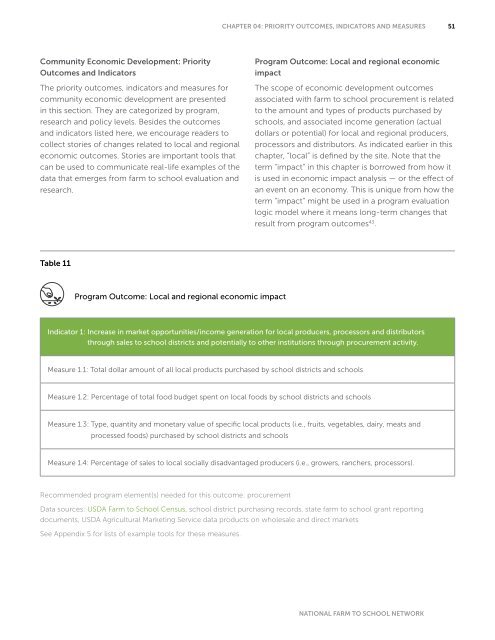Framework-08-25-14_web
Framework-08-25-14_web
Framework-08-25-14_web
You also want an ePaper? Increase the reach of your titles
YUMPU automatically turns print PDFs into web optimized ePapers that Google loves.
CHAPTER 04: PRIORITY OUTCOMES, INDICATORS AND MEASURES51Community Economic Development: PriorityOutcomes and IndicatorsThe priority outcomes, indicators and measures forcommunity economic development are presentedin this section. They are categorized by program,research and policy levels. Besides the outcomesand indicators listed here, we encourage readers tocollect stories of changes related to local and regionaleconomic outcomes. Stories are important tools thatcan be used to communicate real-life examples of thedata that emerges from farm to school evaluation andresearch.Program Outcome: Local and regional economicimpactThe scope of economic development outcomesassociated with farm to school procurement is relatedto the amount and types of products purchased byschools, and associated income generation (actualdollars or potential) for local and regional producers,processors and distributors. As indicated earlier in thischapter, “local” is defined by the site. Note that theterm “impact” in this chapter is borrowed from how itis used in economic impact analysis — or the effect ofan event on an economy. This is unique from how theterm “impact” might be used in a program evaluationlogic model where it means long-term changes thatresult from program outcomes 43 .Table 11Program Outcome: Local and regional economic impactIndicator 1: Increase in market opportunities/income generation for local producers, processors and distributorsthrough sales to school districts and potentially to other institutions through procurement activity.Measure 1.1: Total dollar amount of all local products purchased by school districts and schoolsMeasure 1.2: Percentage of total food budget spent on local foods by school districts and schoolsMeasure 1.3: Type, quantity and monetary value of specific local products (i.e., fruits, vegetables, dairy, meats andprocessed foods) purchased by school districts and schoolsMeasure 1.4: Percentage of sales to local socially disadvantaged producers (i.e., growers, ranchers, processors).Recommended program element(s) needed for this outcome: procurementData sources: USDA Farm to School Census, school district purchasing records, state farm to school grant reportingdocuments, USDA Agricultural Marketing Service data products on wholesale and direct marketsSee Appendix 5 for lists of example tools for these measures.NATIONAL FARM TO SCHOOL NETWORK


